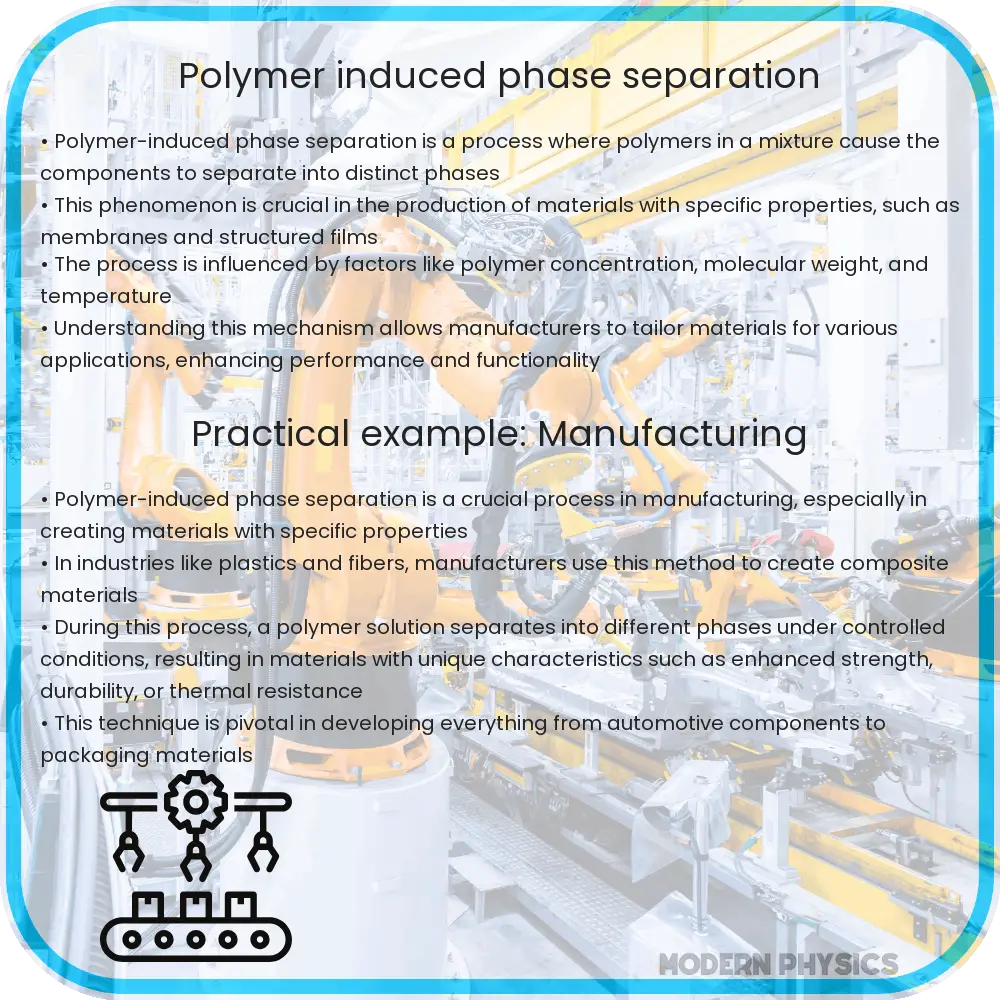Explore the fundamentals of Polymer-Induced Phase Separation (PIPS), including criticality, kinetics, and morphology, and their applications in materials science.

Polymer-Induced Phase Separation: An Overview
Polymer-induced phase separation (PIPS) is a critical phenomenon in the field of materials science, particularly in the fabrication of polymer blends and composites. This process is essential for understanding the physical properties and applications of polymers in various industries, including biomedical, automotive, and consumer products. The PIPS process involves the segregation of a homogenous polymer mixture into two or more distinct phases, driven by differences in polymer composition, molecular weight, or external conditions such as temperature and pressure.
Criticality in Polymer-Induced Phase Separation
The concept of criticality in PIPS refers to the conditions under which the polymer mixture undergoes a transition from a single-phase to a multi-phase system. At the critical point, the system exhibits unique properties such as critical opalescence and a significant increase in correlation length. These properties are crucial for the creation of materials with specific optical, mechanical, or thermal characteristics. Understanding the critical behavior of polymer systems allows for the precise control of phase separation kinetics and the resulting morphology.
Kinetics of Polymer-Induced Phase Separation
The kinetics of PIPS dictates how quickly the phase separation occurs and influences the final structure of the polymer blend. Factors such as temperature quench depth, polymer concentration, and molecular weight distribution play significant roles in determining the rate of phase separation. The kinetics of the process can be classified into different regimes, such as nucleation and growth, spinodal decomposition, and viscoelastic phase separation. Each regime leads to distinct morphological patterns, which can be tailored for specific applications by controlling the phase separation kinetics.
Morphology of Phase-Separated Polymer Systems
The morphology of phase-separated polymer systems is a direct result of the kinetics of PIPS and the conditions under which phase separation occurs. Morphologies such as droplets, fibers, and co-continuous structures can be achieved, influencing the mechanical, optical, and thermal properties of the material. By manipulating variables such as temperature, polymer concentrations, and solvent quality, scientists and engineers can design polymer blends with desired morphologies for various applications.
Factors Influencing Polymer-Induced Phase Separation
Several factors play crucial roles in determining the outcome of polymer-induced phase separation. Temperature, for instance, directly affects the miscibility of polymer components; higher temperatures generally increase miscibility due to enhanced molecular motion. Solvent selection is equally important, as the solvent’s affinity for the polymer components can dramatically influence the phase separation process. Additionally, the molecular weight and distribution of the polymers involved can alter the kinetics and morphology of the resulting phases. Understanding these factors allows for the tailored design of polymer materials with specific characteristics and functionalities.
Applications of Polymer-Induced Phase Separation
PIPS is utilized in a wide array of applications. In biomedical engineering, it is used to create porous structures in scaffolds for tissue engineering, allowing for cell infiltration and nutrient transport. In the field of optics, controlled phase separation can lead to materials with unique refractive properties suitable for lenses and optical filters. Furthermore, in the packaging industry, polymers with specific phase-separated morphologies provide improved barrier properties and mechanical strength, essential for protecting goods during transportation and storage.
Techniques for Analyzing Phase-Separated Polymer Systems
To accurately characterize the morphology and properties of phase-separated polymers, several analytical techniques are employed. Scanning electron microscopy (SEM) and transmission electron microscopy (TEM) are commonly used to observe the detailed structures of the separated phases. Differential scanning calorimetry (DSC) and dynamic mechanical analysis (DMA) provide insight into the thermal and mechanical properties of the polymers, respectively. Understanding these properties is crucial for optimizing the performance of the final material in its intended application.
Conclusion
Polymer-induced phase separation is a complex but critical process in the development of new polymer materials with tailored properties. By understanding the criticality, kinetics, and morphology associated with PIPS, researchers and engineers can design polymers for specific applications, ranging from biomedical devices to consumer products. Factors such as temperature, solvent quality, and molecular weight significantly influence the phase separation process, and mastering these variables allows for the creation of innovative materials with desired functionalities. As technology advances, the understanding and application of polymer-induced phase separation continue to expand, offering new opportunities in materials science and engineering.
